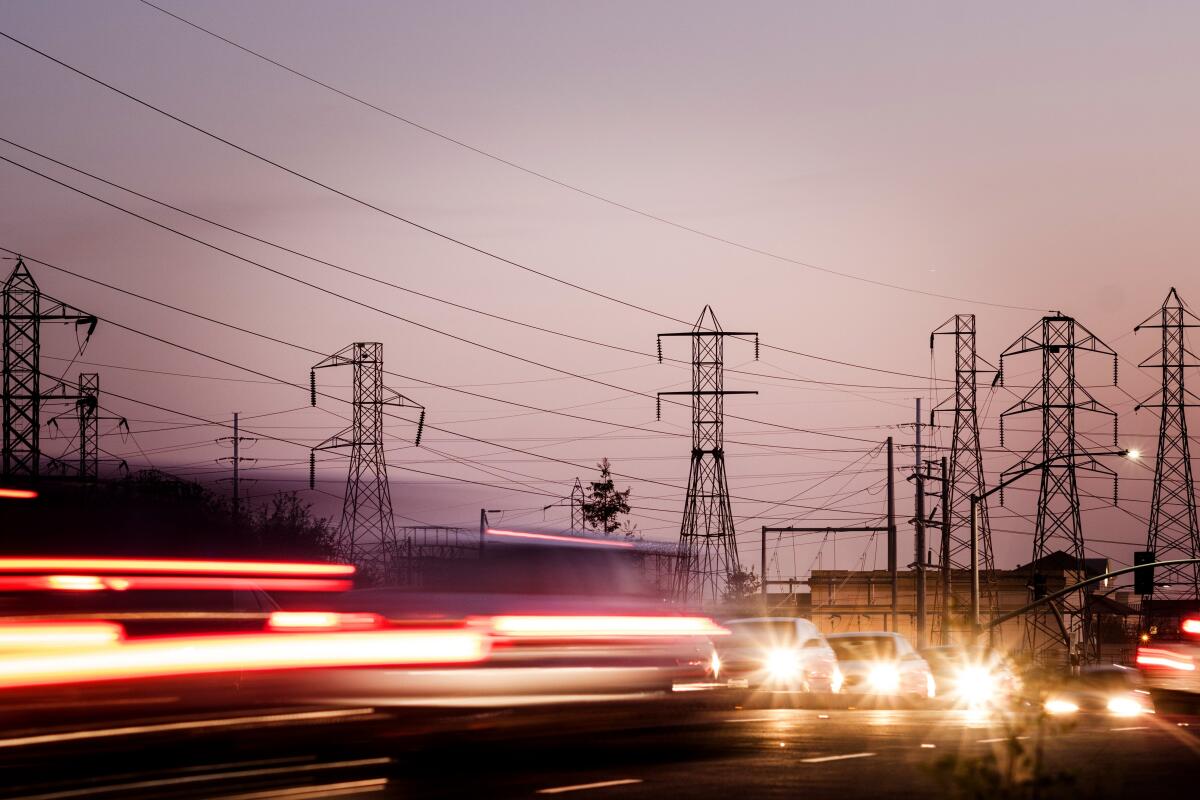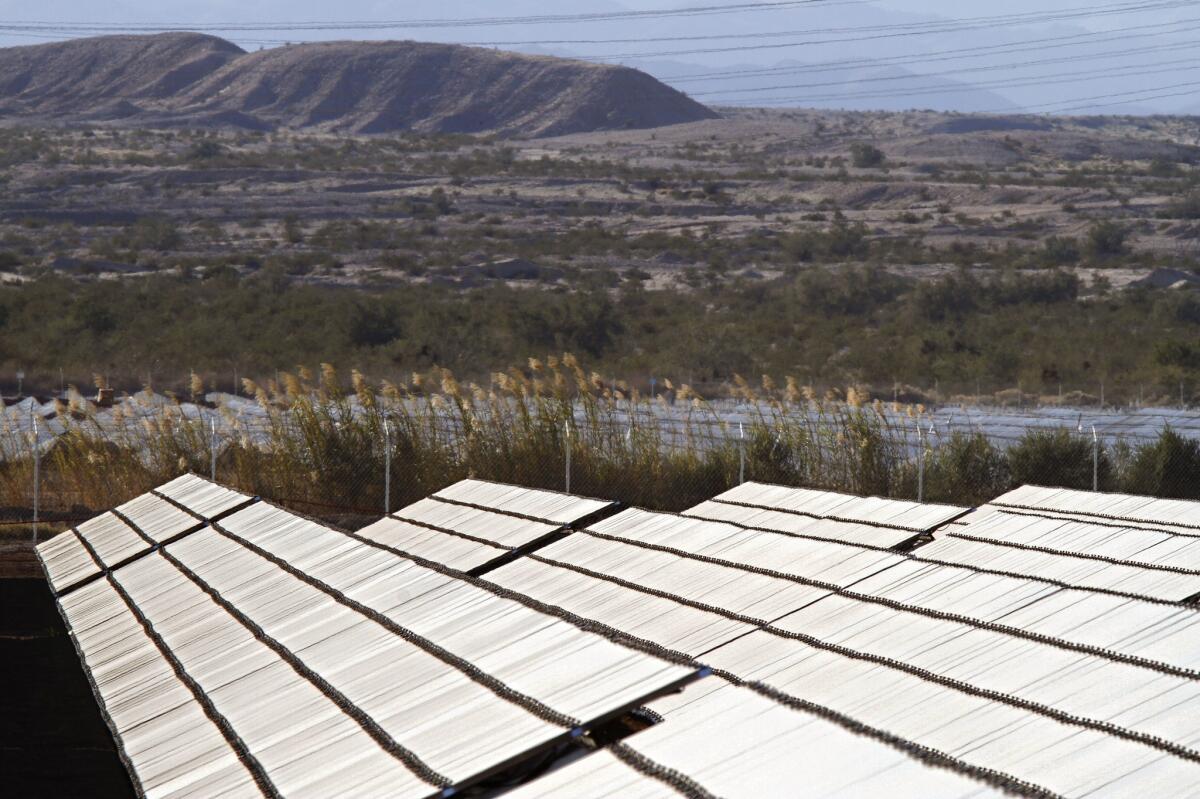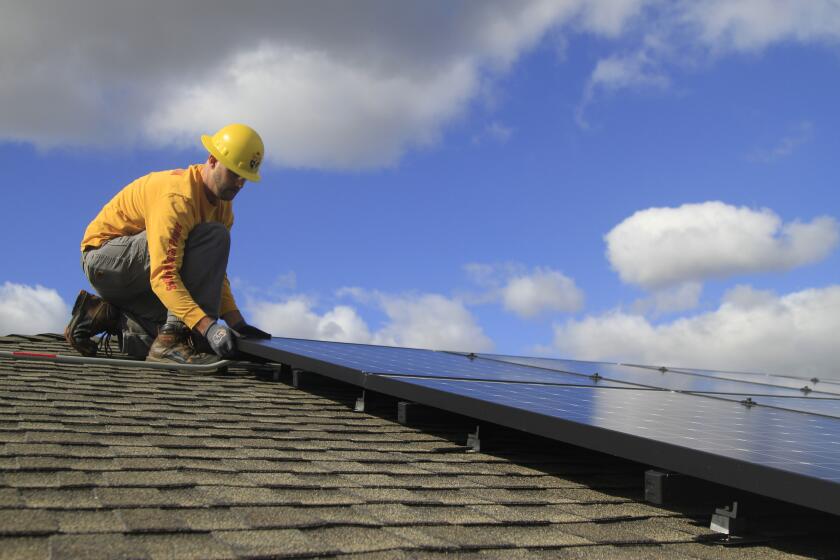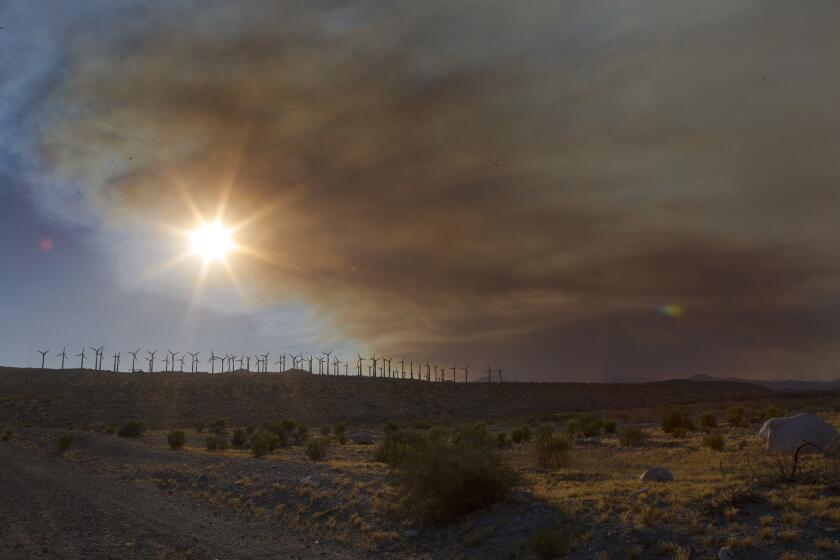Why does California’s power grid keep flirting with disaster? We’ve got answers

California was forced to take desperate measures over Labor Day weekend to keep the lights on.
Less than a month after the state experienced its first rolling blackouts in nearly two decades, officials again urged residents to use less electricity during the late afternoon and into the evening as extreme heat, fueled by the climate crisis, baked the West.
California needed all the conservation it could get as out-of-control fires, also worsened by global warming, rendered some power plants useless. Flames knocked out transmission lines and generators from the Sierra Nevada to the San Diego backcountry.
Just like last month, Californians responded in force, using far less energy than predicted. Electric utilities turned to their Western neighbors for extra power supply. The Trump administration granted an emergency request from state officials to allow three Los Angeles-area gas plants to produce more electricity than federal pollution permits would normally allow.
Record heat. Raging fires. What are the solutions?
Get Boiling Point, our newsletter about climate change, the environment and building a more sustainable California.
You may occasionally receive promotional content from the Los Angeles Times.
And so most of California narrowly avoided shortage-induced rolling blackouts, even as heat-related equipment failures knocked out electricity to 115,000 homes and businesses in Los Angeles, and as Pacific Gas & Electric shut off power to 172,000 customers to reduce the risk of its electrical infrastructure igniting more fires.
State officials are still studying the exact causes of the energy shortages. But they’ve already outlined a few big-picture problems. Some gas-fired power plants have retired, doomed by poor economics and state policies. And California has failed to replace those generators with clean-energy alternatives that can help keep the lights on after sundown, when solar farms go offline.
The state has also become increasingly reliant on energy imports, which are getting scarcer as other Western states join California in looking beyond fossil fuels. And imports can dry up during heat storms that affect the entire West.
For more answers about why California’s power grid keeps flirting with disaster — and what can be done about it — The Times spoke with Stephen Berberich. Since 2011, Berberich has served as president of the California Independent System Operator, the nonprofit corporation that manages most of the state’s power grid. He made news last month when he blamed the state’s Public Utilities Commission for recent power shortfalls, saying the commission had failed to line up adequate supplies.
The following conversation has been edited and condensed for clarity. It was conducted after last month’s rolling blackouts, before this weekend’s heat wave that nearly forced the grid operator to order another round of rotating outages.
Lots of people are trying to blame the rolling blackouts on particular energy sources. Some have said it’s solar power’s fault for not being available at night. Others have talked about wind energy variability. You’ve had people noting that certain gas plants went offline or weren’t available. Does it make sense to blame these power shortages on any one resource?
I think that’s the wrong way to look at it. I’ve looked at all the data. The big picture is that we’re operating too close to the margin and don’t have any room for error.
We are susceptible in exactly the conditions we saw on Friday and Saturday night [Aug. 14 and 15] where you have high net loads — those are the loads at 7 p.m. after the sun has gone down. We knew coming into the day on Friday that we were going to be tight, but that’s not unusual. We’re often tight. And imports generally take care of the gap. In this case, because it was hot in the West, we weren’t able to get the imports we would normally get. Renewables are not at the heart of the issues we had on Friday night.
On Saturday, there was some movement of wind around the time of the net peak. Wind did move 1,000 megawatts up and down and back up, but that shouldn’t be a problem if you weren’t so close to the margin.
The gas fleet performed pretty well, in my estimation, and everything else performed pretty well. This was a matter of running out of capacity to serve load.

There’s been discussion in recent years of California having too much electricity supply, and having overpaid to build unnecessary gas plants following the early-2000s energy crisis. So how are we having power shortages?
If you do a spreadsheet model of all the capacity on the system you get a very large number. But that counts solar as being wholly deliverable across all 24 hours, which is not the case. Solar has virtually no value in the net peak hours, in the evening.
I was in the control room on Friday, and I watched everything that went on, and I think the operators did exactly what they were supposed to do to protect the grid. They ended up making a trade-off of shedding 500 megawatts of load to make sure you don’t end up blacking out the entire state of California, or potentially the rest of the Western grid.
There are a lot of people that suggest we should just deploy our operating reserves to serve load. You simply can’t do that. You must protect the broader grid at all times. And if you deploy your operating reserves to serve load, and the Diablo Canyon nuclear plant trips offline, the grid’s going to collapse.
And then you get a situation like the Northeast blackout of 2003, or the Southwest blackout of 2011.
That’s exactly right. You pay a smaller price to avoid a bigger one, basically.
Power grid managers typically aim to avoid shortage-induced blackouts more than one day every 10 years. Since California hadn’t faced rolling outages in nearly 20 years, should we see the recent outages as an expected once-a-decade event?
I think there is a trade-off between how much money you want to spend on the electric system and the risk of outages. Obviously you want to minimize outages. But I think building the system to protect against any and all contingencies, such as heat across the entire West — I think there’s a trade-off to be had. Every once in a while you’re going to have a disruption.
California is moving quickly to reduce planet-warming emissions by replacing fossil fuels with renewable energy. That means more solar panels and wind turbines, and fewer gas-fired power plants. Do these power shortages mean we’ll need to keep operating some or all of the state’s gas plants for the long term?
I take a different conclusion. I think you have to make sure you’re provided for across all hours. You don’t necessarily have to have a gas fleet to do that. As an example, you could deploy batteries.
What you do have to plan for charging those batteries and serving electricity load at the same time. Just deploying batteries won’t fix it. You have to have a comprehensive strategy. Maybe you charge them at night with the wind. But I don’t necessarily come to the conclusion that you have to keep a big gas fleet.
What you have to do is adequately serve all hours, and there are other strategies to do it other than having a gas fleet. My view is that we need to better do that strategy.
Well-intentioned climate policies don’t necessarily create good jobs. UC Berkeley researchers have some ideas for California.
The Public Utilities Commission recently ordered utilities to buy thousands of megawatts of new clean energy resources, mostly batteries, to replace four gas plants along the Southern California coast. Will those batteries be enough to allow the gas plants to close in the next few years?
I would advocate to have the Public Utilities Commission order additional procurement right now, immediately, to build up our capacity margins going into next summer.
California currently plans its power supply requirements based on the amount of electricity needed to meet demand in an average weather year. Do we need to adjust our planning standards to account for climate change?
I think we have to come to terms with the fact that the world is warming, and we’re going to have more of these hot spells. That absolutely has to be looked at.
It’s not unusual for us to get hot in California. In 2017, we saw 50,116 megawatts of peak demand. You can do that if the rest of the West isn’t hot because you can get the imports to fill in the gap. But if you’re going to have these West-wide heat waves like we have now, we can’t assume we’re going to get those imports anymore.
We talked earlier about what’s an acceptable outage level. There probably is some. But if you’re going to have these continued heat waves, you’re going to have more of these outages. And I think that’s untenable, from a real perspective and also from a political perspective.
One politically controversial idea that former Gov. Jerry Brown pushed during his administration was merging California’s power grid with other Western states. Opponents worried about giving up control of the state’s energy supply. Would it help you keep the lights on to have a fully integrated regional grid?
Absolutely, you would have gotten rid of the friction on imports. You wouldn’t have imports or exports, you’d just have electricity flowing around. But as you can imagine, I’m kind of fatigued about that regionalization battle.
Another idea for keeping the lights on is “demand response” programs that pay people to use electricity during different times of day, or to contribute power to the grid if they’ve got an electric vehicle or a battery. We don’t have much formal, automated demand response in California right now, so instead the state has been begging people to use less electricity. How do we get more homes and businesses enrolled in these programs?
I’ve had discussions with the governor’s office and the Public Utilities Commission about that very topic. How do we operationalize what we just did? Because we were calling around for megawatts. The Navy took some ships off of shore power, and Tesla helped out, and the oil refineries helped out.
We have markets and compensation for those things. I think we have to work with the regulators and the utilities to get those programs working so that people will come. But we have the markets for it. Let’s get it online and let’s get it aggregated.
A bit of Jewish wisdom might help: “It is not your responsibility to finish the work of perfecting the world, but you are not free to desist from it either.”
I’ve also heard a lot about “virtual power plants” that bring together networks of rooftop solar panels and batteries in people’s garages, and operate those resources in unison to provide energy to the grid during times of stress. Should the Independent System Operator encourage or facilitate more virtual power plants?
Yes, it is something we’re interested in, and we’ll do our best to encourage it. But keep in mind, what we do is create markets and dispatch based on what we get in the market. We need programs that bring virtual power plants to the market. I think the utilities and their regulators need to figure out how to deploy that more broadly, and get these people who responded over the last few days into those programs.
The rolling outages of the early-2000s energy crisis were caused by Enron and other companies manipulating California’s power markets, by withholding supplies to artificially raise prices. Is it possible that could be happening again now?
The outage numbers are frankly lower than they normally are, so I don’t see evidence of withholding. We haven’t seen anything unusual in the patterns of imports and exports. But it will take a deeper dive. So immediately, I don’t see any evidence, but that doesn’t mean it’s not there. And I think we need to do our best to look into it.
The penalties and the trouble you can get into by trying to manipulate our markets are very extreme. And I do think people have learned their lesson. I could be wrong. We will do a look into it. Our Department of Market Monitoring will, I’m sure, be watching and looking into this very closely.









